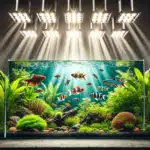Over time, algae, hard water stains, and other residues can accumulate on the glass of your fish tank, obstructing your view and encouraging the build up of algae. Common issues include algae growth, hard water stains (calcium deposits), and cloudy glass caused by biofilm or mineral residues. This guide will walk you through the process of effectively and safely cleaning your fish tank glass.
Why Is Cleaning Fish Tank Glass Important?
There are a few benefits associated with cleaning your aquarium glass:
- Enhanced Visibility: Clear glass allows you to fully enjoy the beauty of your fish tank.
- Fish Health: Algae and residue buildup can affect water quality, leading to potential imbalances in your tank.
- Preventing Damage: Certain residues, like hard water stains, can become more difficult to remove over time and may damage the glass.
Tools and Supplies You’ll Need to Clean Aquarium Glass
There are a wide variety of tools available that you can use to clean the glass of your aquarium. Here is a list of the most common:
- Algae Scraper or Pad: Designed to remove algae without scratching the glass. Even some coarse filter sponge can work well for this.
- Magnetic Glass Cleaner: Allows you to clean the inside glass without getting your hands wet. An effective tool for cleaning algae from the inside of the aquarium glass. It has a rough scrubbing pad on one side that glides along the tank’s interior when you move the handle on the outside, making cleaning easier without reaching into the tank. Do watch out for small snails or sand that can get trapped between the magnetics, as these can lead to scratches on the inside of your glass.
- Filter Brush: Essential for maintaining aquarium filters by effectively cleaning away sludge that accumulates in the small crevices of the filter assembly, ensuring optimal performance and preventing harmful buildup.
- Razor Blade: A very effective tool for removing stubborn residue from glass. Of course this option comes with a number of safety considerations – razor blades are very sharp and should only be handled by an adult. If your tank is made of acrylic glass, you’ll want to use a plastic razor blade instead, to prevent scratching of the acrylic surface.
- Soft Sponge or Microfiber Cloth: For wiping down the glass; avoid using abrasive materials.
- White Vinegar: A natural, non-toxic cleaner effective against hard water stains, above the water line.
- Aquarium-Safe Glass Cleaner: Specifically formulated to be safe for fish when cleaning the exterior glass.
Step-by-Step Instructions on How to Clean Fish Tank Glass Without Harming Your Fish
Step 1: Preparing the Aquarium for Cleaning
- Turn Off Electric Equipment: Switch off heaters, filters, and any other electrical devices to ensure safety.
- Remove Decorations: Take out any removable decorations that block access to the inside of the glass.
- Partial Water Change: While not always necessary, performing a partial water change can help maintain water quality during cleaning. Ensure the replacement water matches the temperature of the existing aquarium water to minimise stress. See here for a guide on water changes.
Step 2: Removing Algae from Fish Tank Glass
- Use an Algae Scraper or Pad: Gently scrub the inside glass to remove algae. Start from the top and work your way down to prevent debris from settling on already cleaned areas.
- Employ a Magnetic Glass Cleaner: For hard-to-reach spots or to avoid getting your hands wet, use a magnetic cleaner.
- Be Gentle: Avoid using excessive force to prevent scratching the glass. Move slowly and avoid sudden movements to keep your fish calm during the cleaning process.
Step 3: Cleaning Hard Water Stains on Aquarium Glass
- Apply White Vinegar: Dampen a cloth with white vinegar and gently rub the stained areas. Vinegar helps dissolve mineral deposits. (Try not to get too much in the water if using on a running fish tank, as it can affect the pH in large amounts.)
- Let It Sit: Allow the vinegar to sit on stubborn stains for a few minutes before wiping.
- Rinse Thoroughly: After cleaning, rinse the area with clean water to ensure no vinegar residue remains, as it can alter the tank’s pH.
Step 4: Polishing and Preventing Foggy Glass
- Use a Microfiber Cloth: Wipe down the exterior glass with a microfiber cloth to remove fingerprints and smudges without leaving streaks.
- Avoid Household Cleaners: Standard glass cleaners can leave residues harmful to fish. Always use aquarium-safe products. A white vinegar and water solution is a good, natural alternative for this.
- Regular Maintenance: Regular cleaning prevents the buildup of residues that cause foggy glass.
Step 5: Cleaning the Outside of the Fish Tank
Cleaning the outside of the fish tank is just as important as cleaning the inside. Here’s how to do it effectively:
- Wipe Down the Exterior: Use a soft, lint-free cloth or paper towel to gently wipe down the outside of the tank. This will remove any dust, dirt, or debris that has accumulated.
- Remove exterior stains: Use stimilar techniques as mentioned above to tackle any stains on the glass.
Common Challenges When Cleaning Aquarium Glass
Dealing with White Residue on Aquarium Glass
White residue is often due to hard water deposits (calcium/limescale) :
- Use Vinegar: As mentioned, vinegar effectively dissolves these mineral deposits.
- Prevent Buildup: Regular cleaning and using softer water can help prevent future deposits.
Preventing Algae Buildup in Fish Tanks
- Control Lighting: Excessive light promotes algae growth. Limit tank lighting to 8-10 hours a day.
- Manage Nutrients: Overfeeding can increase nutrients that algae thrive on. Feed your fish only what they can consume in a few minutes.
- Introduce Algae Eaters: Species like nerite snails or otocinclus catfish naturally consume algae, helping keep it in check. Here’s a list of some good algae eaters you might consider for your fish tank.
DIY and Eco-Friendly Cleaning Methods
- Baking Soda Paste: Mix baking soda with water to form a paste. Apply it to stains, let it sit, then scrub gently.
- Lemon Juice: The acidity in lemon juice can help dissolve mineral deposits. Apply, let sit, and rinse thoroughly.
- Avoid Chemicals: Natural methods are safer for your fish and the environment.



